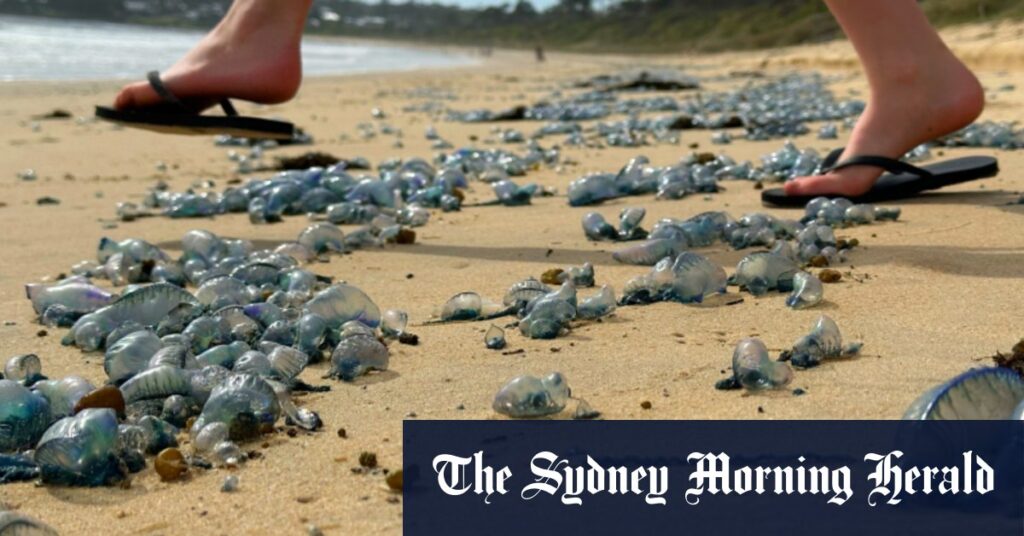North-easterly winds were most associated with stings at both beaches even though south-easterly winds also shepherd bluebottles to shore, possibly because north-easterlies are associated with warm beach weather while southerlies deliver drizzle, keeping swimmers away.
Clovelly is even more south-facing and at the end of a narrow bay. North-easterly winds only produced a 4 per cent chance of bluebottles, but the risk rose to 12 per cent the day after a southerly.
The findings can be applied to other beaches; north-easterlies are also likely to bring bluebottles to east-facing beaches such as Manly while Bondi is more susceptible to southerlies.
Bluebottles – not a kind of jellyfish but rather a cnidarian collective of four specialised animals called zooids – can slightly contract or elongate their sails and tentacles, but are mostly at the whim of the weather.
The organisms are pushed in different directions by the same wind depending on whether their sail arcs to the right or left. A new study using 3D-printed replicas confirmed “right-handed” bluebottles are pushed about 45-50 degrees to the left, and the “left-handed” ones veer to the right.
“We know bluebottles are pushed around 50⁰ left or right of the wind direction. So a quick drawing in your head or on the sand may tell you which nearby beach is likely to be safest,” study authors Dr Amandine Schaeffer from the UNSW and Dr Jaz Lawes from Surf Life Saving Australia wrote in The Conversation.
Graphic showing trajectory of bluebottles with right or left-handed sails in a lab study.Credit: Bourg et al, Marine Pollution Bulletin
The different sails are probably an evolutionary strategy. If a wind blows a swarm of bluebottles on shore to perish with a pop under beachgoers’ thongs, the gust will usher the other half out into the ocean to continue hunting the currents. About 75 per cent of bluebottles washing up in Sydney are lefties, which tend to be ushered in by north-easterlies.
If the wind is stronger than 30 km/h, however, all bluebottles are pushed the same way – potentially leading to a more stinger-strewn beach.
The research team also launched 3D-printed fake bluebottles with trackers 15 kilometres off Botany in January 2024 to gather more data on how a bluebottle makes it to shore. (One of the models washed up on Bondi with a bunch of real bluebottles; another was pinched by a dog on Palm Beach.)
A map that looks back in time using bluebottle, wind and ocean data to find where bluebottles originated from before ending up beached in Sydney. Shades of blue represent left-handed bluebottles and shades of red represent right-handed.Credit: UNSW
Weather and wind direction is easy enough to model. But the biological factors of where exactly bluebottles breed and what triggers the arrival of a swarm is harder to nail down.
The researchers have harnessed machine learning and oceanographic models to help unpick the thorny mystery, and have traced back through weather data to chart where the bluebottles possibly came from.
“Some of them take these crazy pathways,” Lawes said. “They’re coming from as far up as Papua New Guinea.”
There appears to be a peak of plentiful larger-bodied bluebottles in October, while second peak of a different species strikes in February.
“The overall outcome is to use all this information to make a predictive tool that beachgoers can use to make decisions about their own safety,” Lawes said. “So perhaps people won’t be schlepping kids down to beach only to find a blanket of blue that packs a nasty sting.”
The tool, called BluebottleWatch, is planned to roll out in the Beachsafe app.
What should you do if you are stung?
- Wash off any remaining tentacles with seawater, or pick off with your fingers (they can’t usually sting through the tough skin on your fingers);
- Immerse the patient’s sting in hot water (no hotter than can be easily tolerated);
- If local pain is not relieved or immersion facilities are not available, applying cold packs or wrapped ice is also effective.
- Refer to medical aid for further treatment if condition deteriorates.
- Peeing on the sting is not recommended. Urine can be acidic or alkaline, and alkaline pee can actually trigger more stinging cells and increase the severity of the sting.
Read the full article here


